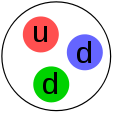Neutron interferometer
In physics, a neutron interferometer is an interferometer capable of diffracting neutrons, allowing the wave-like nature of neutrons, and other related phenomena, to be explored.
| Science with neutrons |
|---|
 |
| Foundations |
|
| Neutron scattering |
| Other applications |
|
| Infrastructure |
|
| Neutron facilities |
Interferometry
Interferometry inherently depends on the wave nature of the object. As pointed out by de Broglie in his PhD thesis, particles, including neutrons, can behave like waves (the so-called wave–particle duality, now explained in the general framework of quantum mechanics). The wave functions of the individual interferometer paths are created and recombined coherently which needs the application of dynamical theory of diffraction. Neutron interferometers are the counterpart of X-ray interferometers and are used to study quantities or benefits related to thermal neutron radiation.
Applications
Neutron interferometers are used to determine minute quantum-mechanical effects on the neutron wavefunction, such as studies of the Aharonov–Bohm effect, gravity acting on an elementary particle, the neutron, rotation of the earth acting on a quantum system and they can be applied for neutron phase imaging, and tests of the dynamical theory of diffraction.
Construction
Like X-ray interferometers, neutron interferometers are typically made from a single large crystal of silicon, often 10 to 30 or more centimeters in diameter and 20 to 60 cm or more in length. Modern semiconductor technology allows large single-crystal silicon boules to be easily grown. Since the boule is a single crystal, the atoms in the boule are precisely aligned, to within small fractions of a nanometer or an angstrom, over the entire boule. The interferometer is created by removing all but three slices of silicon, held in perfect alignment by a base. (image) Neutrons impinge on the first slice, where, by diffraction from the crystalline lattice, they separate into two beams. At the second slice, they are diffracted again, with two beams continuing on to the third slice. At the third slice, the beams recombine, interfering constructively or destructively, completing the interferometer. Without the precise, angstrom-level alignment of the three slices, the interference results would not be meaningful.
Cold neutrons
Only recently, a neutron interferometer for cold and ultracold neutrons was designed and successfully run. Neutron-optical components in this case comprise three gratings. They are artificially holographically produced, i.e., by means of a light-optic two-wave interference setup illuminating a photo-neutron-refractive polymer.
References
- V. F. Sears, Neutron Optics, Oxford University Press (1998).
- H. Rauch and S. A. Werner, Neutron Interferometry, Clarendon Press, Oxford (2000).